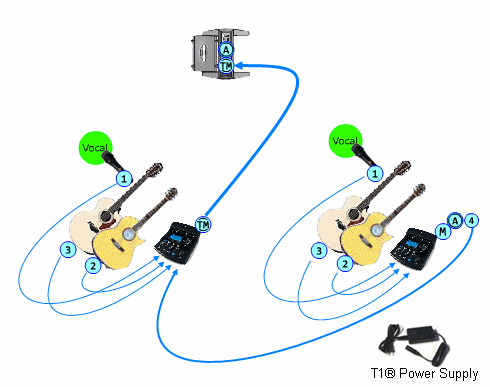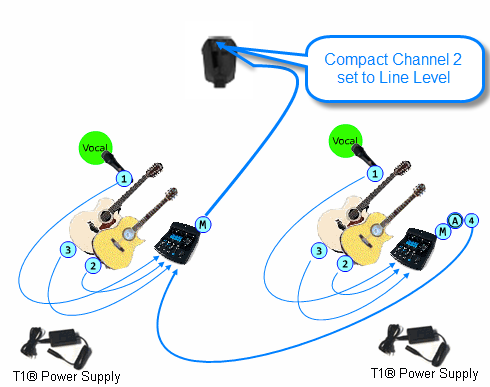Difference between revisions of "T1 ToneMatch® Audio Engine / Daisy Chain"
m |
m |
||
| Line 24: | Line 24: | ||
In this example we have two {{T1}}s. (T1®s) | In this example we have two {{T1}}s. (T1®s) | ||
| − | #{{t1r}} on the left connected to | + | #{{t1r}} on the left connected to [[L1%C2%AE_Compact#Channel_2|Compact Channel 2]] |
#{{t1r}}on the right connected to the {{t1r}} on the left through the Master Analog ¼ inch jack to the other T1® Channel 4 | #{{t1r}}on the right connected to the {{t1r}} on the left through the Master Analog ¼ inch jack to the other T1® Channel 4 | ||
Revision as of 21:12, 16 May 2015
You can daisy chain (connect) one T1 ToneMatch Audio Engine into another.
In this example we have two T1 ToneMatch Audio Engines. (T1®s)
- T1® on the left connected to the L1 Model II through the ToneMatch® Port
- T1®on the right connected to the T1® on the left through the Master Analog ¼ inch jack to the other T1® Channel 4
This allows the performer using T1® #1 to control the overall volume of both T1®s. If the performer controlling T1® # does not adjust the volume of Channel 4, Changing the Master Volume maintains the relative balance between T1® #1 and T1® #2
Notes:
- T1® #2 will require the optional T1 ToneMatch® Audio Engine power supply
- It would be possible to have a third T1® connected to T1® #1 Channel 5
- Related discussion in the message board T1® Daisy Chain
Here's how you can do the same thing with a L1 Compact
In this example we have two T1 ToneMatch Audio Engines. (T1®s)
- T1® on the left connected to Compact Channel 2
- T1®on the right connected to the T1® on the left through the Master Analog ¼ inch jack to the other T1® Channel 4
This allows the performer using T1® #1 to control the overall volume of both T1®s. If the performer controlling T1® # does not adjust the volume of Channel 4, Changing the Master Volume maintains the relative balance between T1® #1 and T1® #2
Notes:
- T1® #1 and #2 will require a T1 ToneMatch® Audio Engine power supply
- It would be possible to have a third T1® connected to T1® #1 Channel 5
- Related discussion in the message board T1® Daisy Chain

